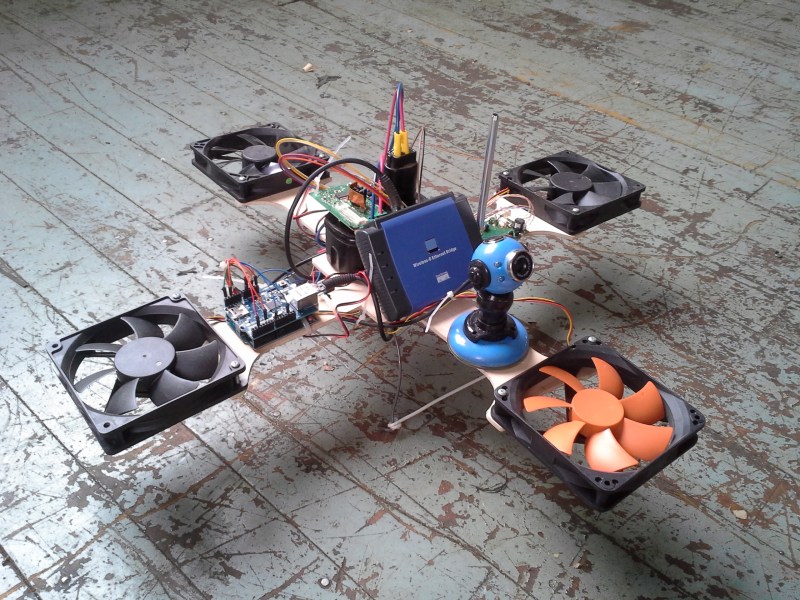The advancement of Quadcopters and their capabilities over the last few years has been amazing. Unfortunately, the price point to get into the sport with a decent size, non-toy, vehicle is still several hundred dollars. And what’s the fun with buying one when you can built it?!? Strapped for cash and feeling the same way, [Hans] over at the hackerspace Knackatory decided to build a quadcopter from e-waste.
The + shaped frame is made from lightweight plywood. It’s pretty obvious that the main rotors are PC Fans, 140mm in this case. Normally, these wouldn’t be able to create enough lift to get out of their own way except the on-board 24v Dewalt cordless tool battery bumps up the fan speed to 15,000 rpm. The one orange fan allows the operator to maintain a visual reference to which side of the ‘copter is forward.
An Arduino running MultiWii control software is the brains of this UAV. The MultiWii software uses the sensors from part of a Nintendo Wii remote to sense orientation and movement. While there is no hand held transmitter with this quadcopter per se, communication to the host computer is handled by a wireless router running OpenWRT. The router is the gateway that allows the Arduino and Ethernet Shield combination to communicate through the Hackerspace’s wifi network. Flight plans are pre-programmed. Admittedly, the real time control through computer keyboard commands needs a little work. The team plans on interfacing a regular USB game controller with the software.
Making stuff out of e-waste is a great way to recycle. Remember this e-waste 3D Printer?


















Ah, that’s nothing, you should see my hummingbird saddle!
hahaha nice one… April the first guys!! :D
If you think that has even a remote chance of being able to fly, please, don’t have children.
So much LOL……
People thinking this is plausible OH LAWDIE.
What you don’t see in the photos is the tiny cat with a tinier slice of buttered bread attached to it’s back to supply the hovering. The fans are obviously only there for directional control. ;)
If only the batteries could be charged by gullibleness of Hack A Day Blog readers.
It’s April 2 where I’m reading this.
This is a joke, granted, but why does everyone keeps insisting that physics doesn’t work? The lift force is proportional to the amount of air the fan moves, the amount of air the fan moves is proportional to fan rotation speed. Fan rotation speed is proportional to voltage. Thus increasing the voltage increases the lift force. The motors in these fans are quite simple the only way they can break is to burn the coils (+ mechanical overheat and jam the bearings). It’s not clear to me at all at what voltage/rpm the motors will burn up. They are in the very center of the airflow so they will get some cooling, it might help to remove the plastic cover cups.
If i had to guess 24v won’t generate enough lift, maybe 48? 96? Run the batteries in series. Also i’d guess that drill batteries won’t generate nearly enough current.
If i’d had a bench PSU i would run one of these up to see where it breaks. Wouldn’t be surprised if it can lift itself up.
Something like this: https://www.youtube.com/watch?v=ibNPGk5FZxY
It’s like running your car on nitroglycerine and expecting it to go at 600mph. It won’t work. The fans are digitally controlled by an onboard chip. And they just don’t have the strength to take the power that they’d need to work like this.
Proper model aircraft motors are designed to take huuuge currents for massive power. PC fans, basically, aren’t.
Internal combustion engine is a bad metaphor, those are a lot more complex.
Are you sure PC fans have electronics in them? I would think they are simple motors with just coils of copper wire and brushes if that. They are not _designed_ to work at voltages significantly above 12, that’s true. But as video above demonstrates a good quality cooling fan can be overvolted 3 fold. And at 30 volts it can drag a huge copper heatsink around. So in this case it’s more a question of quality then design. I’m almost sure those zalman fans could be used to make a quadcopter; two problems there: they probably don’t run well in reverse and they will cost more then a dedicated copter motor.
I dunno about the specific fans you mention, but generally motors are made for a specific voltage, and anything much over pushes the mechanics, and has a good chance of burning out the coils. A good motor is a well-thought-out piece of engineering, everything designed to work together at rated speed and torque. Not too unlike an IC engine.
Anyway… PC fans have a little chip on board, yes. They’re brushless, many DC motors nowadays are. If you take one apart, you’ll see several poles with coils on them, each coil is energised in turn by the control chip. The rotor is just the plastic blade assembly with 1 magnet in it, and no other parts.
A Hall-effect sensor detects the magnet coming round each turn, and the control IC uses that to regulate the timing of the coils. Using this method is much better than brushed motors. For one, nothing brushing against anything, no touching moving parts (apart from the bearing), so it never wears out. Secondly, brushes produce sparks, and it must be enough of a challenge routing hundreds of microwave-frequency lines all over a 12-layer motherboard, without having spark-gap transmitters all over the place.
I think the main problem with over-volting them, would be burning out the wires or components. They don’t design them with slack in, why would they? They’re sold by the million for an identical purpose each time.
Most high-performance model aircraft motors are brushless nowadays too. It’s only cheap motors, or high-power motors, that still have brushes.
Also to be fair, the vid’s called “indestructible Zalman”. Zalman make high-performance, expensive, fans and heatsinks. I can imagine the way the fan was blowing air over the motor helped keep it on this side of meltdown. Even then it’s surprising, I bet it wouldn’t keep up for long though at that voltage. And it barely lifted the heatsink partly off the ground.
Of course you can get powerful motors, but not in general PC fans. Even the one in the vid wouldn’t be able to lift much for long.
If it lifts your spirits, where is the beverage holder?
Okay but this throws down the gauntlett for someone to make it happen for real now ;o)
Yesterday this was true! Yesterday my PC tower flew through the window… I had to run for it and guess what? It hit a plane (I live near an airport)… [NO] Of course the plane didn’t crashed but my PC tower did… Oh well… Gotta buy another PC tower… These 15k rpm fans are just too much… You gotta be careful. REALLY
Something similar happened the time the door broke on my 20x DVD-ROM drive. The disc flew out, also by a local airport. Fortunately the air force brought it down with a Hellfire missile before any real damage was done.
Because F*** YOU GRAVITY !!!
fake
And I thought I missed out on April Fools. Pretty good!
“But, these fans go up to ELEVEN”
I want to build this. How do I get a list of parts and instructions?
Back in ye olden dayz I tried using two high CFPM fans to make a fireball emitter once.
Didn’t work BUT it did shape the ignition coil discharge somewhat so with more work this could be interesting.
FWIW the fans were run at 14.4V not 12 and the RPM only went up about 5%, the higher powered fans really are running at their limit.
I did read an article in “EPE” about rewinding fan motors with homemade Litz wire to make drone motors, a lot of the problems are due to the rotor becoming saturated so winding it like this increases current slightly and putting a resistor across each winding makes the fields quench a little faster.
Also you need to replace the outer (cheap plastic magnets) with modified superglued NIB or better still samarium cobalt based magnets from old optical drives.
:))))))))))))))))))))) hahahahahh very idiot man, is fake, mega fake
April fool in August ?
Absolutely impossible with this type of motor, fan and weight.
They definitely can lift their own weight (i tried it) but not all that extra weight. And where is the video???
hey guys sorry am an electrician but i love so much electronics can you please help me
https://www.youtube.com/watch?v=WaO4nYUvuWA
truly works
Pls i want to build a quadcopter with computer fan. Pls i need ur help.
It is impossible to fly
Impossible, PC fans have only 2W +/- and slow tortue. More there is a lot of plastic around rotors and rotors itself is robust. One fan is not able to lift even himself. Muset be fake, In one PC fan there goes 0,25A, but quadricopter usually have voltage only lightly lower but tenth of amper go to motors.
I want my house flying with the ceiling fan in next project. 100 percent fake project is published on hackaday.com.
You forget to install the pilot seat for yourself. Oh sorry, I forget, you need this seat in your rocket, to fly you on the moon…
Delta has some really nice hi power fans. 12V 50W, 11500 rpm,
https://www.delta-fan.com/Download/Spec/PFR0912XHE-SP00.pdf
5200L/min or 185 CFM